HONDA ACCORD SEDAN 2000 (in English) User Guide
Manufacturer: HONDA, Model Year: 2000, Model line: ACCORD SEDAN, Model: HONDA ACCORD SEDAN 2000Pages: 329, PDF Size: 4.66 MB
Page 11 of 329
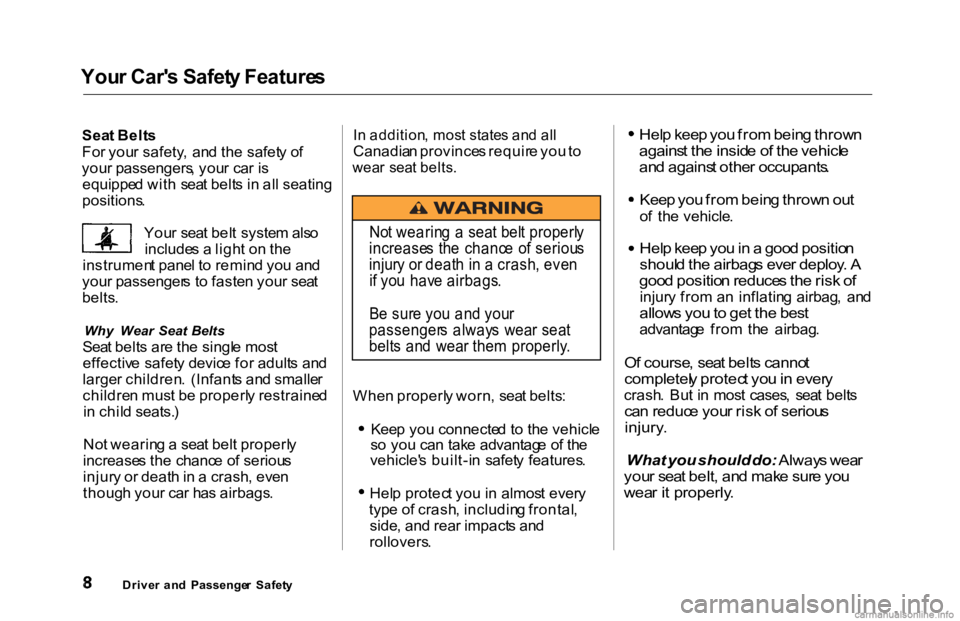
You
r Car' s Safet y Feature s
Sea t Belt s
Fo r you r safety , an d th e safet y o f
you r passengers , you r ca r i s
equippe d wit h sea t belt s i n al l seating
positions .
You r sea t bel t syste m als o
include s a ligh t o n th e
instrumen t pane l t o remin d yo u an d
you r passenger s t o faste n you r sea t
belts .
Why Wear Seat Belts
Sea t belt s ar e th e singl e mos t
effectiv e safet y devic e fo r adult s an d
large r children . (Infant s an d smalle r
childre n mus t b e properl y restraine d
i n chil d seats. )
No t wearin g a sea t bel t properl y
increase s th e chanc e o f seriou s
injur y o r deat h in a crash , eve n
thoug h you r ca r ha s airbags .
I
n addition , mos t state s an d al l
Canadia n province s requir e yo u to
wea r sea t belts .
Whe n properl y worn , sea t belts : Kee
p yo u connecte d t o th e vehicl e
s o yo u ca n tak e advantag e o f th e
vehicle' s built-i n safet y features . Hel
p protec t yo u in almos t ever y
typ e o f crash , includin g frontal ,
side , an d rea r impact s an d
rollovers .
Hel
p kee p yo u fro m bein g throw n
agains t th e insid e o f th e vehicl e
an d agains t othe r occupants .
Kee
p yo u fro m bein g throw n ou t
o f th e vehicle .
Hel
p kee p yo u in a goo d positio n
shoul d th e airbag s eve r deploy . A
goo d positio n reduce s th e ris k o f
injur y fro m a n inflatin g airbag , an d
allow s yo u to ge t th e bes t
advantag e fro m th e airbag .
O f course , sea t belt s canno t
completel y protec t yo u in ever y
crash . Bu t i n mos t cases , sea t belt s
ca n reduc e you r ris k o f seriou s
injury .
What you should do: Always wea r
you r sea t belt , an d mak e sur e yo u
wea r i t properly .
Drive r an d Passenge r Safet y
No
t wearin g a sea t bel t properl y
increase s th e chanc e o f seriou s
injur y o r deat h i n a crash , eve n
i f yo u hav e airbags .
B e sur e yo u an d you r
passenger s alway s wea r sea t
belt s an d wea r the m properly .
Page 12 of 329
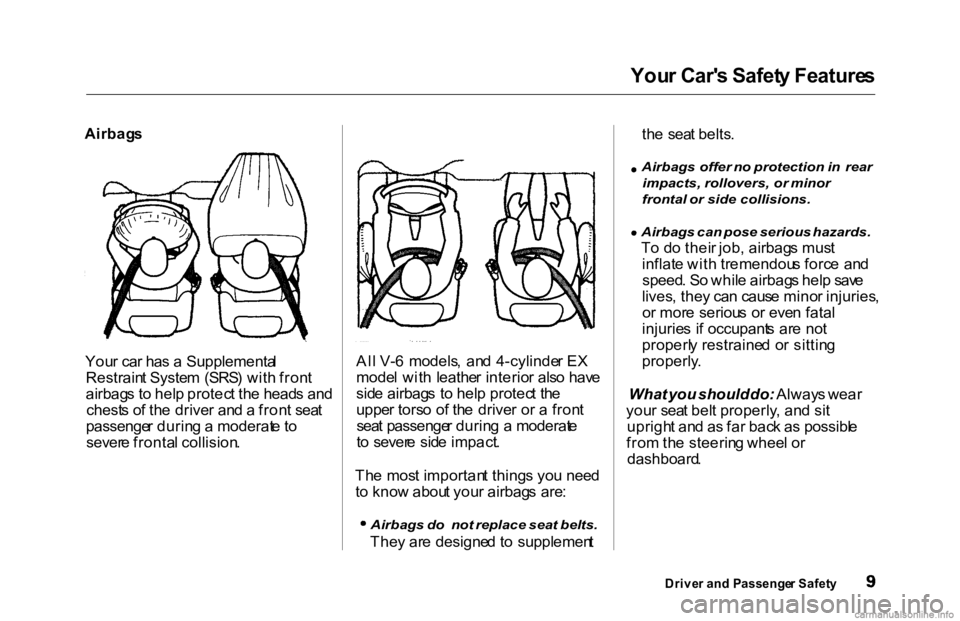
You
r Car' s Safet y Feature s
Airbag s
You r ca r ha s a Supplementa l
Restrain t Syste m (SRS ) wit h fron t
airbag s t o hel p protec t th e head s an d
chest s o f th e drive r an d a fron t sea t
passenge r durin g a moderat e to
sever e fronta l collision . Al
l V- 6 models , an d 4-cylinde r E X
mode l wit h leathe r interio r als o hav e
sid e airbag s t o hel p protec t th e
uppe r tors o o f th e drive r o r a fron t
sea t passenge r durin g a moderat e
t o sever e sid e impact .
Th e mos t importan t thing s yo u nee d
t o kno w abou t you r airbag s are :
Airbags
do not replace seat belts.
The y ar e designe d t o supplemen tth
e sea t belts .
Airbags
offer no protection in rear
impacts, rollovers, or minor
frontal or side collisions. Airbags
can pose serious hazards.
T o d o thei r job , airbag s mus t
inflat e wit h tremendou s forc e an d
speed . S o whil e airbag s hel p sav e
lives , the y ca n caus e mino r injuries ,
o r mor e seriou s o r eve n fata l
injurie s i f occupant s ar e no t
properl y restraine d o r sittin g
properly .
What you should do: Always wear
you r sea t bel t properly , an d sit
uprigh t an d a s fa r bac k a s possibl e
fro m th e steerin g whee l o r
dashboard .
Drive r an d Passenge r Safet y
Page 13 of 329
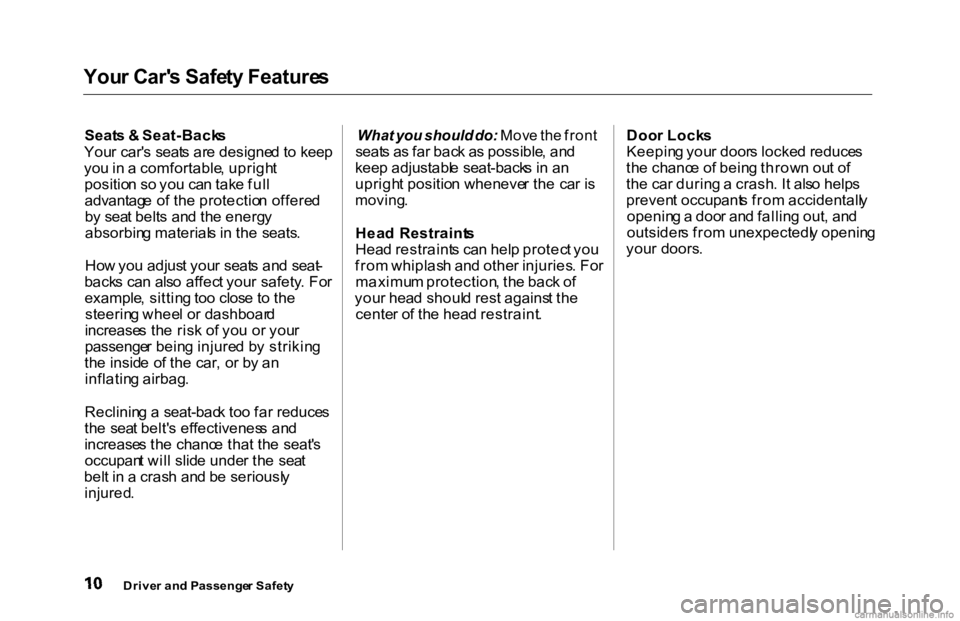
You
r Car' s Safet y Feature s
Seat s & Seat-Back s
You r car' s seat s ar e designe d t o kee p
yo u in a comfortable , uprigh t
positio n s o yo u ca n tak e ful l
advantag e o f th e protectio n offere d
b y sea t belt s an d th e energ y
absorbin g material s i n th e seats .
Ho w yo u adjus t you r seat s an d seat -
back s ca n als o affec t you r safety . Fo r
example , sittin g to o clos e t o th e
steerin g whee l o r dashboar d
increase s th e ris k o f yo u o r you r
passenge r bein g injure d b y strikin g
th e insid e o f th e car , o r b y a n
inflatin g airbag .
Reclinin g a seat-bac k to o fa r reduce s
th e sea t belt' s effectivenes s an d
increase s th e chanc e tha t th e seat' s
occupan t wil l slid e unde r th e sea t
bel t i n a cras h an d b e seriousl y
injured .
What
you should do: Move th e fron t
seat s a s fa r bac k a s possible , an d
kee p adjustabl e seat-back s i n a n
uprigh t positio n wheneve r th e ca r i s
moving .
Hea d Restraint s
Hea d restraint s ca n hel p protec t yo u
fro m whiplas h an d othe r injuries . Fo r
maximu m protection , th e bac k o f
you r hea d shoul d res t agains t th e
cente r o f th e hea d restraint . Doo
r Lock s
Keepin g you r door s locke d reduce s
th e chanc e o f bein g throw n ou t o f
th e ca r durin g a crash . I t als o help s
preven t occupant s fro m accidentall y
openin g a doo r an d fallin g out , an d
outsider s fro m unexpectedl y openin g
you r doors .
Drive r an d Passenge r Safet y
Page 14 of 329
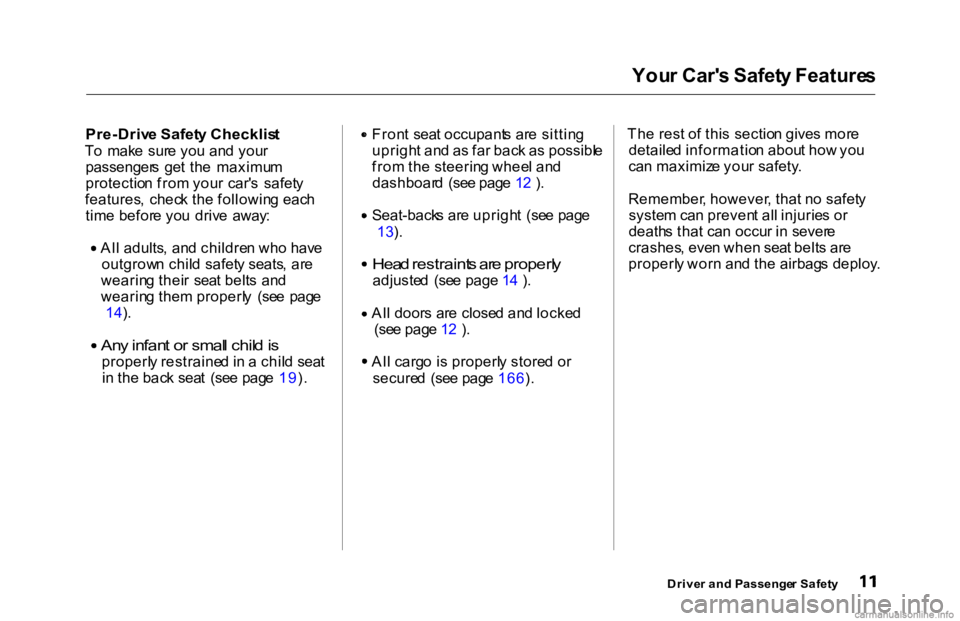
You
r Car' s Safet y Feature s
Pre-Driv e Safet y Checklis t
T o mak e sur e yo u an d you r
passenger s ge t th e maximu m
protectio n fro m you r car' s safet y
features , chec k th e followin g eac h
tim e befor e yo u driv e away : Al
l adults , an d childre n wh o hav e
outgrow n chil d safet y seats , ar e
wearin g thei r sea t belt s an d
wearin g the m properl y (se e pag e
14 ).
An
y infan t o r smal l chil d is
properl y restraine d in a chil d sea t
i n th e bac k sea t (se e pag e 19 ). Fron
t sea t occupant s ar e sittin g
uprigh t an d a s fa r bac k a s possibl e
fro m th e steerin g whee l an d
dashboar d (se e pag e 1 2 ) . Seat-back
s ar e uprigh t (se e pag e
13 ).
Hea
d restraint s ar e properl y
adjuste d (se e page 1 4 ) . Al
l door s ar e close d an d locke d
(se e pag e 1 2 ). Al
l carg o i s properl y store d o r
secure d (se e pag e 166 ). Th
e res t o f thi s sectio n give s mor e
detaile d informatio n abou t ho w yo u
ca n maximiz e you r safety .
Remember , however , tha t n o safet y
syste m ca n preven t al l injurie s o r
death s tha t ca n occu r i n sever e
crashes , eve n whe n sea t belt s ar e
properl y wor n an d th e airbag s deploy .
Drive r an d Passenge r Safet y
Page 15 of 329
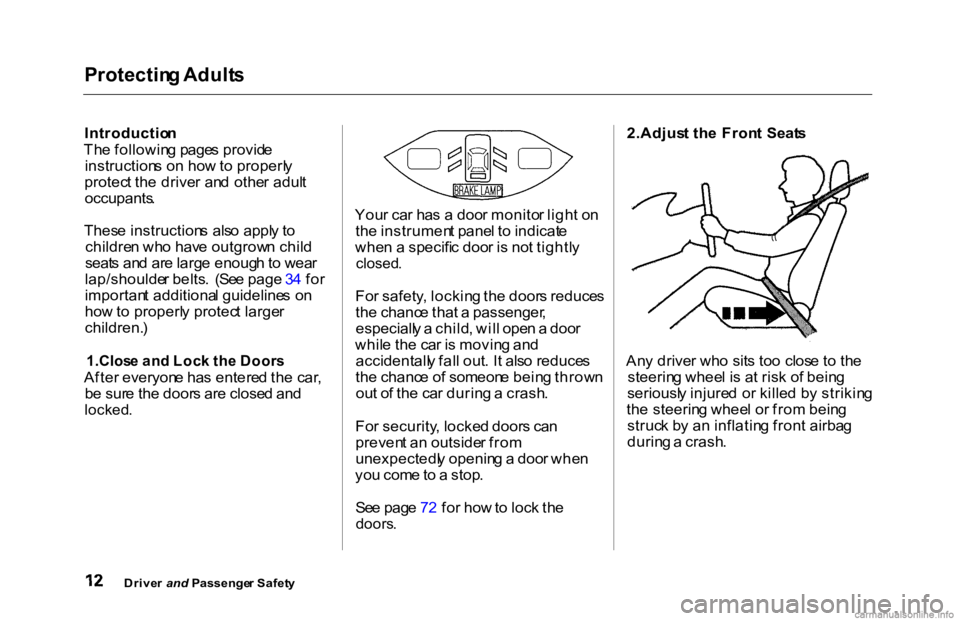
Protectin
g Adult s
Introductio n
Th e followin g page s provid e
instruction s o n ho w to properl y
protec t th e drive r an d othe r adul t
occupants .
Thes e instruction s als o appl y t o
childre n wh o hav e outgrow n chil d
seat s an d ar e larg e enoug h to wea r
lap/shoulde r belts . (Se e page 3 4 fo r
importan t additiona l guideline s o n
ho w to properl y protec t large r
children. )
1 .Clos e an d Loc k th e Door s
Afte r everyon e ha s entere d th e car ,
b e sur e th e door s ar e close d an d
locked .
You
r ca r ha s a doo r monito r ligh t o n
th e instrumen t pane l t o indicat e
whe n a specifi c doo r i s no t tightl y
closed .
Fo r safety , lockin g th e door s reduce s
th e chanc e tha t a passenger ,
especiall y a child , wil l ope n a doo r
whil e th e ca r i s movin g an d
accidentall y fal l out . I t als o reduce s
th e chanc e o f someon e bein g throw n
ou t o f th e ca r durin g a crash .
Fo r security , locke d door s ca n
preven t a n outside r fro m
unexpectedl y openin g a doo r whe n
yo u com e to a stop .
Se e pag e 7 2 fo r ho w to loc k th e
doors .
2.Adjus
t th e Fron t Seat s
An y drive r wh o sit s to o clos e t o th e
steerin g whee l i s a t ris k o f bein g
seriousl y injure d o r kille d b y strikin g
th e steerin g whee l o r fro m bein g
struc k b y a n inflatin g fron t airba g
durin g a crash .
Drive r and Passenge r Safet y
Page 16 of 329
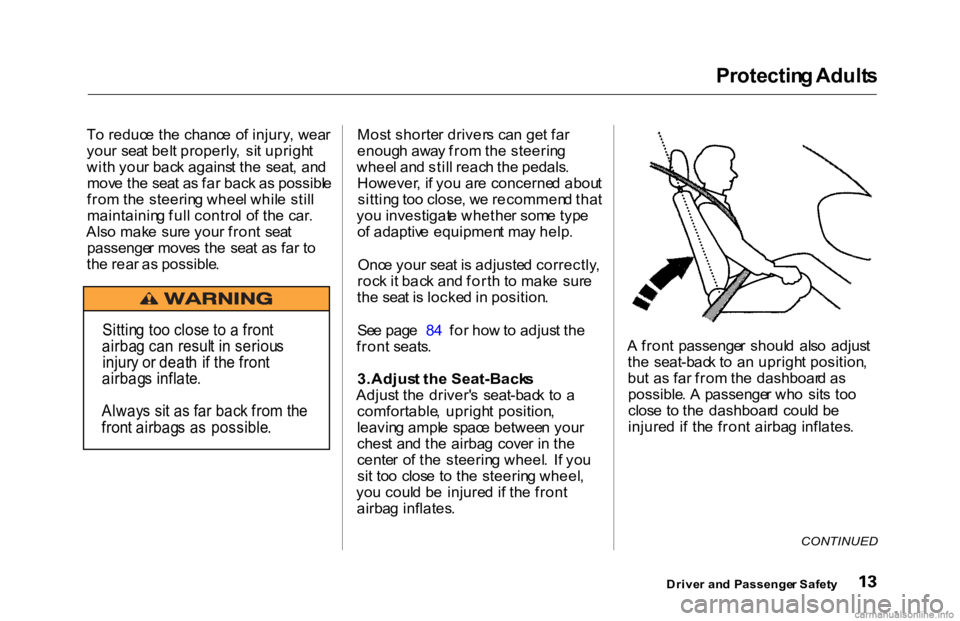
Protectin
g Adult s
T o reduc e th e chanc e o f injury , wea r
you r sea t bel t properly , si t uprigh t
wit h you r bac k agains t th e seat , an d
mov e th e sea t a s fa r bac k a s possibl e
fro m th e steerin g whee l whil e stil l
maintainin g ful l contro l o f th e car .
Als o mak e sur e you r fron t sea t
passenge r move s th e sea t a s fa r t o
th e rea r as possible . Mos
t shorte r driver s ca n ge t fa r
enoug h awa y fro m th e steerin g
whee l an d stil l reac h th e pedals .
However , i f yo u ar e concerne d abou t
sittin g to o close , w e recommen d tha t
yo u investigat e whethe r som e typ e
o f adaptiv e equipmen t ma y help .
Onc e you r sea t i s adjuste d correctly ,
roc k i t bac k an d fort h t o mak e sur e
th e sea t i s locke d in position .
Se e pag e 84 fo r ho w to adjus t th e
fron t seats .
3.Adjus t th e Seat-Back s
Adjus t th e driver' s seat-bac k t o a
comfortable , uprigh t position ,
leavin g ampl e spac e betwee n you r
ches t an d th e airba g cove r i n th e
cente r o f th e steerin g wheel . I f yo u
si t to o clos e t o th e steerin g wheel ,
yo u coul d b e injure d i f th e fron t
airba g inflates . A
fron t passenge r shoul d als o adjus t
th e seat-bac k t o a n uprigh t position ,
bu t a s fa r fro m th e dashboar d a s
possible . A passenge r wh o sit s to o
clos e t o th e dashboar d coul d b e
injure d i f th e fron t airba g inflates .
CONTINUED
Drive r an d Passenge r Safet y
Sittin
g to o clos e t o a fron t
airba g ca n resul t i n seriou s
injur y o r deat h i f th e fron t
airbag s inflate .
Alway s si t a s fa r bac k fro m th e
fron t airbag s a s possible .
Page 17 of 329
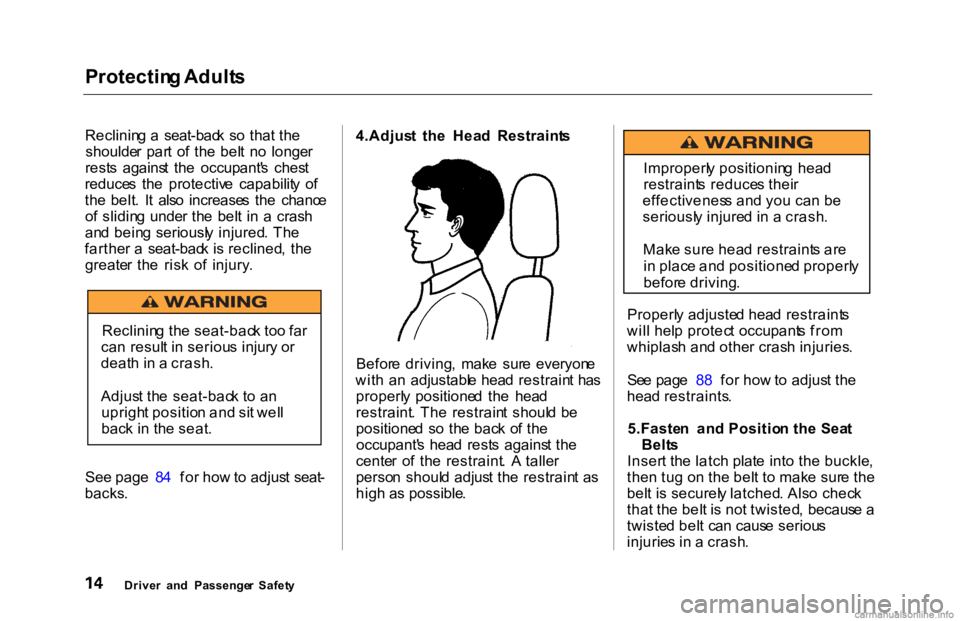
Protectin
g Adult s
Reclinin g a seat-bac k s o tha t th e
shoulde r par t o f th e bel t n o longe r
rest s agains t th e occupant' s ches t
reduce s th e protectiv e capabilit y o f
th e belt . I t als o increase s th e chanc e
o f slidin g unde r th e bel t i n a cras h
an d bein g seriousl y injured . Th e
farthe r a seat-bac k i s reclined , th e
greate r th e ris k o f injury .
See page 8 4 fo r ho w to adjus t seat -
backs . 4.Adjus
t th e Hea d Restraint s
Befor e driving , mak e sur e everyon e
wit h a n adjustabl e hea d restrain t ha s
properl y positione d th e hea d
restraint . Th e restrain t shoul d b e
positione d s o th e bac k o f th e
occupant' s hea d rest s agains t th e
cente r o f th e restraint . A talle r
perso n shoul d adjus t th e restrain t a s
hig h a s possible . Properl
y adjuste d hea d restraint s
wil l hel p protec t occupant s fro m
whiplas h an d othe r cras h injuries .
Se e pag e 88 fo r ho w to adjus t th e
hea d restraints .
5.Faste n an d Positio n th e Sea t
Belt s
Inser t th e latc h plat e int o th e buckle ,
the n tu g o n th e bel t t o mak e sur e th e
bel t i s securel y latched . Als o chec k
tha t th e bel t i s no t twisted , becaus e a
twiste d bel t ca n caus e seriou s
injurie s i n a crash .
Drive r an d Passenge r Safet y
Reclinin
g th e seat-bac k to o fa r
ca n resul t i n seriou s injur y o r
deat h in a crash .
Adjus t th e seat-bac k t o a n
uprigh t positio n an d si t wel l
bac k i n th e seat . Improperl
y positionin g hea d
restraint s reduce s thei r
effectivenes s an d yo u ca n b e
seriousl y injure d i n a crash .
Mak e sur e hea d restraint s ar e
i n plac e an d positione d properl y
befor e driving .
Page 18 of 329
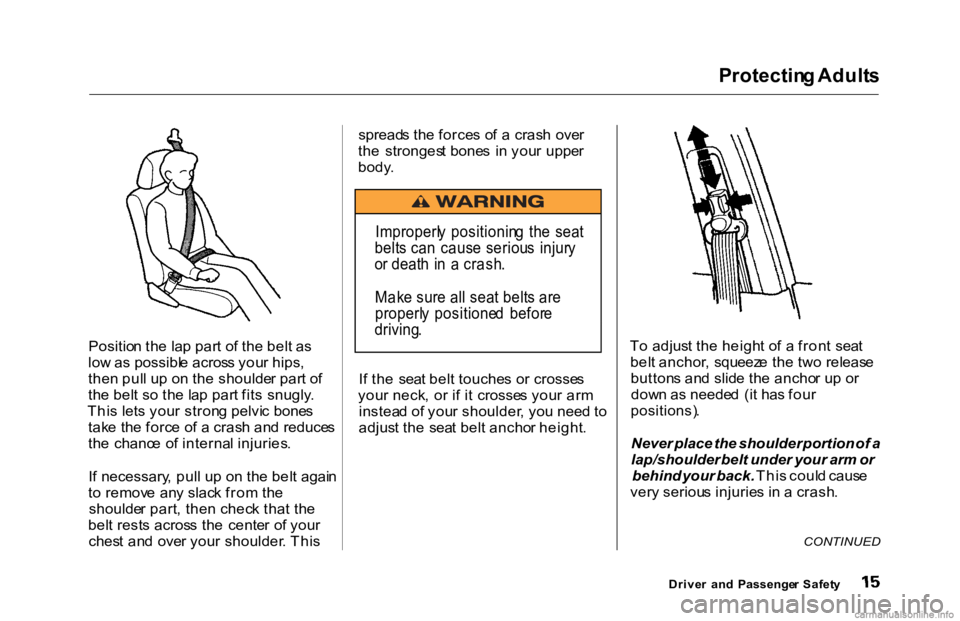
Protectin
g Adult s
Positio n th e la p par t o f th e bel t a s
lo w a s possibl e acros s you r hips ,
the n pul l u p o n th e shoulde r par t o f
th e bel t s o th e la p par t fit s snugly .
Thi s let s you r stron g pelvi c bone s
tak e th e forc e o f a cras h an d reduce s
th e chanc e o f interna l injuries .
I f necessary , pul l u p o n th e bel t agai n
t o remov e an y slac k fro m th e
shoulde r part , the n chec k tha t th e
bel t rest s acros s th e cente r o f you r
ches t an d ove r you r shoulder . Thi s spread
s th e force s o f a cras h ove r
th e stronges t bone s i n you r uppe r
body .
I f th e sea t bel t touche s o r crosse s
you r neck , o r i f i t crosse s you r ar m
instea d o f you r shoulder , yo u nee d t o
adjus t th e sea t bel t ancho r height . T
o adjus t th e heigh t o f a fron t sea t
bel t anchor , squeez e th e tw o releas e
button s an d slid e th e ancho r u p o r
dow n a s neede d (i t ha s fou r
positions) .
Never place the shoulder portion of a
lap/shoulder belt under your arm or
behind your back. This coul d caus e
ver y seriou s injurie s i n a crash .
CONTINUED
Drive r an d Passenge r Safet y
Improperl
y positionin g th e sea t
belt s ca n caus e seriou s injur y
o r deat h i n a crash .
Mak e sur e al l sea t belt s ar e
properl y positione d befor e
driving .
Page 19 of 329
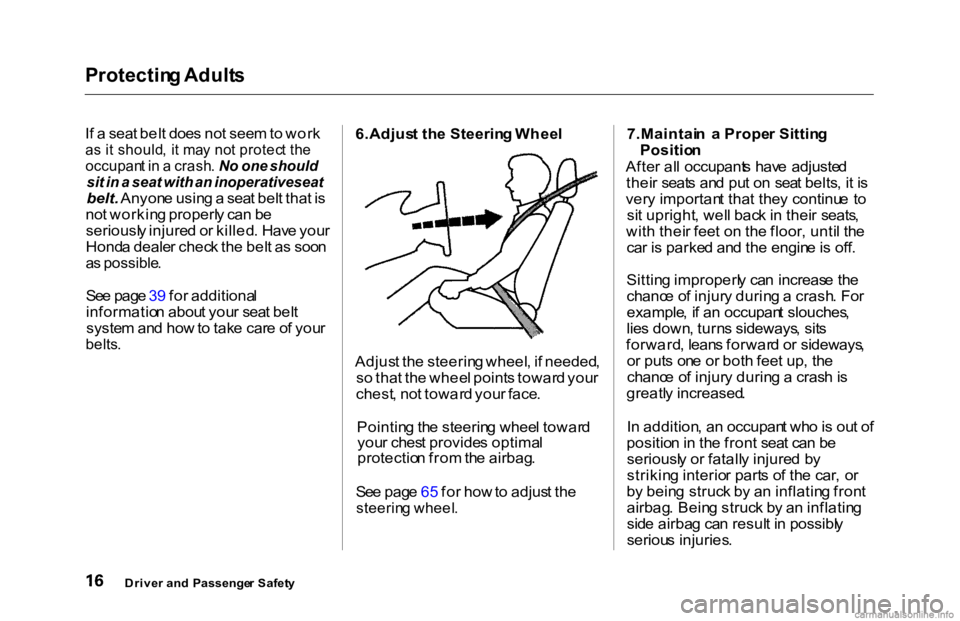
Protectin
g Adult s
I f a sea t bel t doe s no t see m to wor k
a s i t should , i t ma y no t protec t th e
occupan t i n a crash . N o one should
sit in a seat with an inoperative seat
belt. Anyon e usin g a sea t bel t tha t i s
no t workin g properl y ca n b e
seriousl y injure d o r killed . Hav e you r
Hond a deale r chec k th e bel t a s soo n
a s possible .
Se e pag e 3 9 fo r additiona l
informatio n abou t you r sea t bel t
syste m an d ho w to tak e car e o f you r
belts .
6.Adjus
t th e Steerin g Whee l
Adjus t th e steerin g wheel , i f needed ,
s o tha t th e whee l point s towar d you r
chest , no t towar d you r face .
Pointin g th e steerin g whee l towar d
you r ches t provide s optima l
protectio n fro m th e airbag .
Se e pag e 6 5 fo r ho w to adjus t th e
steerin g wheel .
7.Maintai
n a Prope r Sittin g
Positio n
Afte r al l occupant s hav e adjuste d
thei r seat s an d pu t o n sea t belts , i t i s
ver y importan t tha t the y continu e t o
si t upright , wel l bac k in thei r seats ,
wit h thei r fee t o n th e floor , unti l th e
ca r i s parke d an d th e engin e is off .
Sittin g improperl y ca n increas e th e
chanc e o f injur y durin g a crash . Fo r
example , i f a n occupan t slouches ,
lie s down , turn s sideways , sit s
forward , lean s forwar d o r sideways ,
o r put s on e o r bot h fee t up , th e
chanc e o f injur y durin g a cras h is
greatl y increased .
I n addition , a n occupan t wh o is ou t o f
positio n in th e fron t sea t ca n b e
seriousl y o r fatall y injure d b y
strikin g interio r part s o f th e car , o r
b y bein g struc k b y a n inflatin g fron t
airbag . Bein g struc k b y a n inflatin g
sid e airba g ca n resul t i n possibl y
seriou s injuries .
Drive r an d Passenge r Safet y
Page 20 of 329
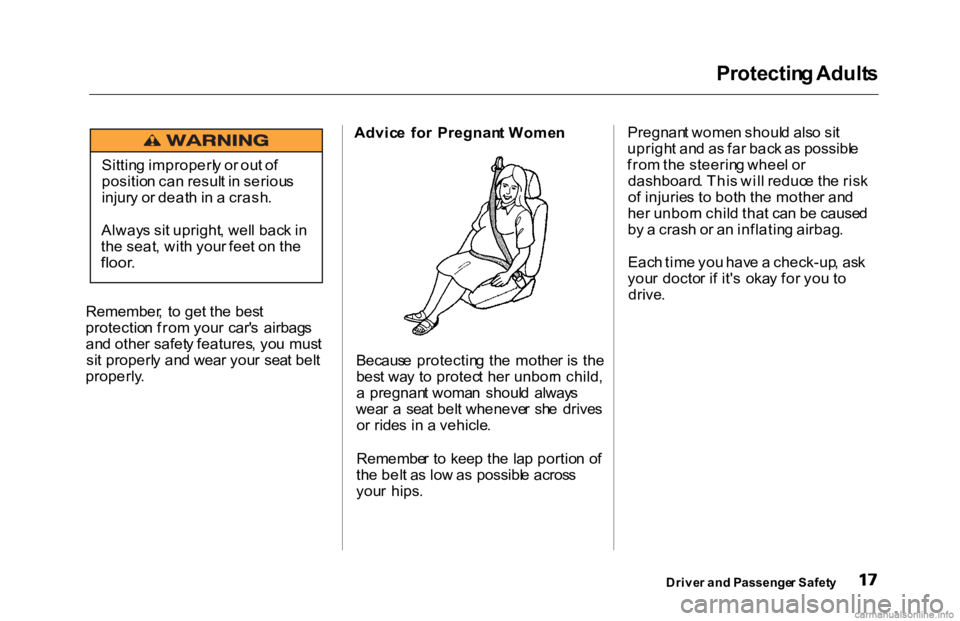
Protectin
g Adult s
Remember , t o ge t th e bes t
protectio n fro m you r car' s airbag s
an d othe r safet y features , yo u mus t
si t properl y an d wea r you r sea t bel t
properly . Advic
e fo r Pregnan t Wome n
Becaus e protectin g th e mothe r i s th e
bes t wa y t o protec t he r unbor n child ,
a pregnan t woma n shoul d alway s
wea r a sea t bel t wheneve r sh e drive s
o r ride s i n a vehicle .
Remembe r t o kee p th e la p portio n o f
th e bel t a s lo w a s possibl e acros s
you r hips . Pregnan
t wome n shoul d als o si t
uprigh t an d a s fa r bac k a s possibl e
fro m th e steerin g whee l o r
dashboard . Thi s wil l reduc e th e ris k
o f injurie s t o bot h th e mothe r an d
he r unbor n chil d tha t ca n b e cause d
b y a cras h o r a n inflatin g airbag .
Eac h tim e yo u hav e a check-up , as k
you r docto r i f it' s oka y fo r yo u t o
drive .
Drive r an d Passenge r Safet y
Sittin
g improperl y o r ou t o f
positio n ca n resul t i n seriou s
injur y o r deat h in a crash .
Alway s si t upright , wel l bac k i n
th e seat , wit h you r fee t o n th e
floor .